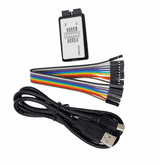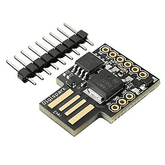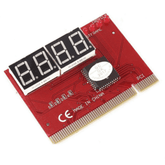What is a Logic Analyzer
Summary
Are you curious about logic analyzers and their incredible potential in the world of electronic testing and debugging? In our latest blog, we delve into the fascinating realm of logic analyzers, exploring their development, unique characteristics, and how they compare to oscilloscopes. We also uncover various types of logic analyzers available in the market and highlight their diverse applications across industries. Whether you're an electronics enthusiast or a seasoned professional, this engaging and informative blog will empower you to make the most of logic analyzers, unlocking a world of precise digital signal analysis and troubleshooting.
What is a Logic Analyzer:
A Logic Analyzer is a form of electronic testing equipment that has the capability to capture and present multiple digital signals within a unified display. It offers a visual representation of how a digital system behaves, allowing for easy analysis and comprehension. It is used to troubleshoot and debug digital circuits by measuring the timing and voltage of digital signals.

Logic Analyzer Development:
The first Logic Analyzer was developed in the 1970s as a tool for debugging digital circuits. Throughout the years, this technology has progressed and incorporated increasingly advanced features, including greater memory depth, higher sample rates, and enhanced triggering options. Presently, Logic Analyzers find application in a diverse array of industries, spanning electronics, computer engineering, automotive, and aerospace.
Logic Analyzer Characteristics:
Some common characteristics of a Logic Analyzer include:- High-speed data acquisition: Logic Analyzers can typically sample digital signals at high speeds, allowing them to capture and display fast-changing digital signals.
- High memory depth: Logic Analyzers have large memory buffers, allowing them to store and display a large number of digital samples.
- Advanced triggering options: Logic Analyzers have advanced triggering options, such as edge triggering and pattern triggering, that allow you to capture specific digital events of interest.
- Decoding of digital protocols: Numerous Logic Analyzers are equipped with built-in support for decoding prevalent digital protocols, including I2C, SPI, and UART. This capability simplifies the process of analyzing and comprehending the data that is captured, facilitating a deeper understanding of the signals being examined.
- Multiple channel inputs: Logic Analyzers typically have multiple channels, allowing them to capture and display multiple digital signals at the same time.
- Time-correlated measurements: Logic Analyzers can display digital signals in a time-correlated manner, allowing you to see how different digital signals are related to one another in time.
- Easy-to-read visual display: Logic Analyzers typically have user-friendly graphical interfaces that make it easy to view and analyze the digital signals being captured.
- Compatibility with a variety of devices: Logic Analyzers can be connected to different devices, such as microcontrollers, FPGAs, and other digital circuits, to analyze the signals coming from them.
- Remote control and data transfer: Some Logic Analyzers can be controlled remotely, and data can be transferred to a computer for further analysis.
- Compatibility with different operating systems: Logic Analyzers' software can be compatible with different operating systems like Windows, Linux, and Mac.
These are some of the common characteristics of a Logic Analyzer, but it may vary depending on the specific model and manufacturer.
Logic Analyzer vs Oscilloscope Comparison:
A Logic and an Oscilloscope are both test and measurement instruments, but they are used for different types of signals. An oscilloscope is used to display and analyze analog signals, while a Logic Analyzer is used for digital signals. Logic Analyzers are better suited for debugging digital systems, while oscilloscopes are better suited for analog systems.
|
Logic Analyzer |
Oscilloscope |
|
Measure and display digital signals |
Measure and display analog signals |
|
Record data before displaying |
store and display small snapshots |
|
Can store long data |
Displays signals in real time |
|
Offers features unique to digital systems, like protocol analyzers |
Offers real-time features, like fast Fourier transform (FFT) |
|
Detect timing Violations |
Characterize aspects like waveform jitter and stability |
Logic Analyzer Types:
There are several types of Logic Analyzers available, including:
- Portable Logic Analyzers: A portable logic analyzer is a type of test and measurement instrument that is designed to be portable and easy to use. It is typically smaller and more compact than a traditional benchtop logic analyzer, and can be powered by a battery or an external power supply. A portable logic analyzer is equipped with a small display screen, and can also connect to a computer for more detailed analysis.
- Modular Logic Analyzers: A modular logic analyzer is a type of test and measurement instrument that can be used to analyze and debug digital circuits. It typically consists of a main unit, called the logic analyzer module, which connects to a set of input probes that are connected to the circuit under test. The logic analyzer module then captures and stores data from the circuit, and displays the data on a computer screen for analysis. One of the main advantages of a modular logic analyzer is that it can be easily configured and reconfigured for different types of circuits and applications, by adding or changing input probes as needed.
- PC-Based Logic Analyzers: A PC-based logic analyzer is a type of test and measurement instrument that connects to a personal computer (PC) to capture and analyze digital signals. The logic analyzer hardware, typically in the form of a PCI card or a USB device, is installed into the PC and connects to the circuit under test using probes. The software running on the PC is used to control the logic analyzer hardware and display the captured data.
Logic Analyzer Applications:
Logic Analyzers are used in a wide range of applications, including:
- Debugging digital circuits: By capturing and analyzing digital signals, logic analyzers play a vital role in identifying and troubleshooting issues within digital circuits. They enable the detection of problems and facilitate their resolution through comprehensive analysis of the captured signals.
- Protocol analysis: Logic analyzers can be used to decode and display different communication protocols, such as I2C, UART, SPI, and USB.
- Embedded systems development: Logic analyzers can be used to debug and test firmware and software on embedded systems, such as microcontrollers and FPGAs.
- Verification of digital designs: Logic analyzers can be used to verify that a digital design is functioning as expected by capturing and analyzing the digital signals in the circuit.
- Power analysis: Logic analyzers can also be used to monitor the power consumption of a digital circuit and identify power-related issues.
- Security testing: Logic analyzers can be used to identify vulnerabilities in digital systems by capturing and analyzing the digital signals on a circuit.
- Automotive testing: Logic analyzers have the capability to diagnose and validate different automotive systems, including engine control, transmission control, anti-lock braking systems, and other electronic control units. They serve as valuable tools for troubleshooting and testing these systems, ensuring their optimal performance and functionality.
- Medical equipment testing: Logic analyzers can be used to test and debug digital systems in medical equipment such as patient monitors, imaging equipment and other diagnostic equipment.
Conclusion
A logic analyzer is a powerful tool used in electronics to capture, analyze, and troubleshoot digital signals. Its development has revolutionized the field, enabling engineers to delve deeper into the inner workings of digital systems. With its unique characteristics, such as high channel counts and advanced triggering capabilities, logic analyzers provide unmatched precision and insight. When compared to oscilloscopes, logic analyzers offer specialized functionality for digital signals. From general-purpose to protocol-specific types, logic analyzers cater to diverse application needs. Embracing a logic analyzer opens doors to efficient debugging, protocol analysis, and system optimization in various industries.
If you appreciate our work don't forget to share this post and leave your opinion in the comment box.
Please do check out other blog posts about Popular electronics
Make sure you check out our wide range of products and collections (we offer some exciting deals!)








